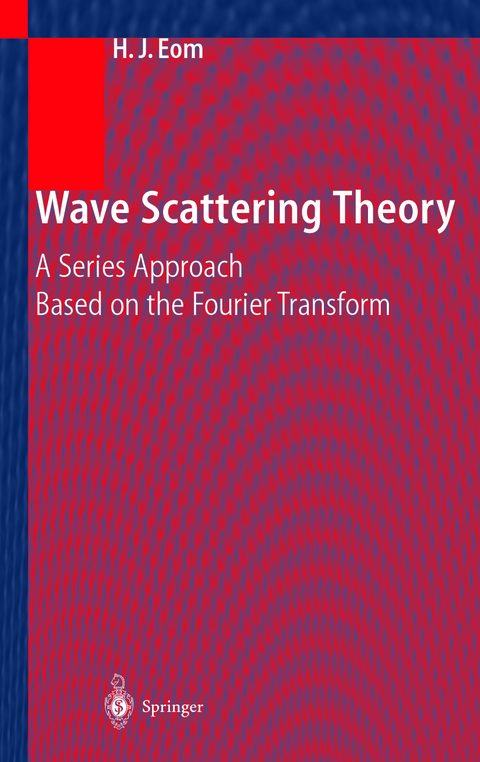
Wave Scattering Theory
Springer Berlin (Verlag)
978-3-642-63995-1 (ISBN)
1. Rectangular Grooves in a Plane.- 1.1 EM Scattering from a Rectangular Groove in a Conducting Plane.- 1.2 EM Scattering from Multiple Grooves in a Conducting Plane.- 1.3 EM Scattering from Grooves in a Dielectric-Covered Ground Plane.- 1.4 EM Scattering from Rectangular Grooves in a Parallel-Plate Waveguide.- 1.5 EM Scattering from Double Grooves in Parallel Plates [18].- 1.6 Water Wave Scattering from Rectangular Grooves in a Plane.- References for Chapter 1.- 2. Flanged Parallel-Plate Waveguide Array.- 2.1 EM Radiation from a Flanged Parallel-Plate Waveguide.- 2.2 EM Radiation from a Parallel-Plate Waveguide into a Dielectric Slab.- 2.3 TE Scattering from a Parallel-Plate Waveguide Array [18].- 2.4 EM Radiation from Obliquely-Flanged Parallel Plates.- 2.5 EM Radiation from Parallel Plates with a Window [24].- References for Chapter 2.- 3. Slits in a Plane.- 3.1 Electrostatic Potential Distribution Through a Slit in a Plane [1].- 3.2 Electrostatic Potential Distribution due to a Potential Across a Slit [3].- 3.3 EM Scattering from a Slit in a Conducting Plane.- 3.4 Magnetostatic Potential Distribution Through Slits in a Plane.- 3.5 EM Scattering from Slits in a Conducting Plane [13].- 3.6 EM Scattering from Slits in a Parallel-Plate Waveguide.- 3.7 EM Scattering from Slits in a Rectangular Cavity.- 3.8 EM Scattering from Slits in Parallel-Conducting Planes [31].- References for Chapter 3.- 4. Waveguides and Couplers.- 4.1 Inset Dielectric Guide.- 4.2 Groove Guide [4].- 4.3 Multiple Groove Guide [8].- 4.4 Corrugated Coaxial Line [10].- 4.5 Coaxial Line with a Gap [13].- 4.6 Coaxial Line with a Cavity [16].- 4.7 Corrugated Circular Cylinder [18].- 4.8 Parallel-Plate Double Slit Directional Coupler [23].- 4.9 Parallel-Plate Multiple Slit Directional Coupler [29].- References for Chapter 4.- 5. Junctions in Parallel-Plate/Rectangular Waveguide.- 5.1 T-Junction in a Parallel-Plate Waveguide.- 5.2 E-Plane T-Junction in a Rectangular Waveguide [6].- 5.3 H-Plane Double Junction [8].- 5.4 H-Plane Double Bend [9].- 5.5 Acoustic Double Junction in a Rectangular Waveguide [11].- 5.6 Acoustic Hybrid Junction in a Rectangular Waveguide [15].- References for Chapter 5.- 6. Rectangular Apertures in a Plane.- 6.1 Static Potential Through a Rectangular Aperture in a Plane.- 6.2 Acoustic Scattering from a Rectangular Aperture in a Hard Plane [7].- 6.3 Electrostatic Potential Through Rectangular Apertures in a Plane [9].- 6.4 Magnetostatic Potential Through Rectangular Apertures in a Plane [10].- 6.5 EM Scattering from Rectangular Apertures in a Conducting Plane [11].- 6.6 EM Scattering from Rectangular Apertures in a Rectangular Cavity [18].- References for Chapter 6.- 7. Circular Apertures in a Plane.- 7.1 Static Potential Through a Circular Aperture in a Plane.- 7.2 Acoustic Scattering from a Circular Aperture in a Hard Plane [6].- 7.3 EM Scattering from a Circular Aperture in a Conducting Plane.- 7.4 Acoustic Radiation from a Flanged Circular Cylinder [15].- 7.5 Acoustic Scattering from Circular Apertures in a Hard Plane [17].- 7.6 Acoustic Radiation from Circular Cylinders in a Hard Plane [19].- References for Chapter 7.- 8. Annular Aperture in a Plane.- 8.1 Static Potential Through an Annular Aperture in a Plane.- 8.2 EM Radiation from a Coaxial Line into a Parallel-Plate Waveguide [6].- 8.3 EM Radiation from a Coaxial Line into a Dielectric Slab [10].- 8.4 EM Radiation from a Monopole into a Parallel-Plate Waveguide [17].- References for Chapter 8.- 9. Circumferential Apertures on a Circular Cylinder.- 9.1 EM Radiation from an Aperture on a Shorted Coaxial Line [1].- 9.2 EM Radiation from Apertures on a Shorted Coaxial Line [3].- 9.3 EM Radiation from Apertures on a Coaxial Line [4].- 9.4 EM Radiation from Apertures on a Coaxial Line with a Cover [6].- 9.5 EM Radiation from Apertures on a Circular Cylinder [10].- References for Chapter 9.- A. Appendix.- A.1 Vector Potentials and Field Representations.
| Erscheint lt. Verlag | 18.9.2011 |
|---|---|
| Zusatzinfo | XII, 244 p. |
| Verlagsort | Berlin |
| Sprache | englisch |
| Maße | 155 x 235 mm |
| Gewicht | 399 g |
| Themenwelt | Informatik ► Theorie / Studium ► Künstliche Intelligenz / Robotik |
| Naturwissenschaften ► Physik / Astronomie ► Mechanik | |
| Technik ► Elektrotechnik / Energietechnik | |
| Schlagworte | antennas • Electromagnetic radiation • electromagnetic wave • electromagnetic waves • Fourier transform • linear acoustic scattering • microwave • Radar • radio-frequency • scattering theory • Wave • wave equation |
| ISBN-10 | 3-642-63995-X / 364263995X |
| ISBN-13 | 978-3-642-63995-1 / 9783642639951 |
| Zustand | Neuware |
| Haben Sie eine Frage zum Produkt? |
aus dem Bereich


